Information
A propos Al-Sabil
Numéros en texte
intégral
Numéro 16
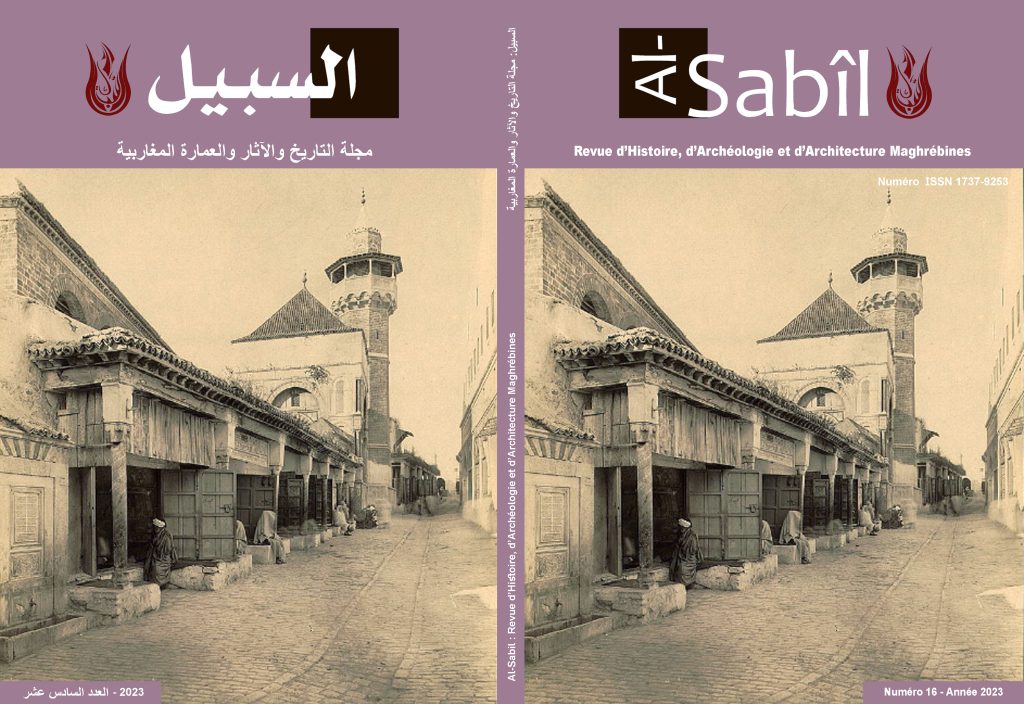
Préface
Richard KLEIN
Introduction
Amina HARZALLAH et Imen REGAYA
Vers une réhabilitation énergétique de l’architecture moderne: Immeubles d’habitation du quartier de St Exupéry à Tunis.
Rania FARAH JAAFAR, Amina HARZALLAH et Leïla AMMAR
El Menzah I : habiter une modernité située.
Narjes BEN ABDELGHANI, Ghada JALLALI et Alia BEN AYED
16 | 2023
Penser le patrimoine industriel minier de la fin du XIXe siècle.
Caractérisation des Atmosphères de la cité minière de Djerissa à travers sa mémoire et son identité im-matérielle
Hedia BEN NILA et Mounir DHOUIB
Table des matieres
Introduction
1. La cité Minière de Djerissa
2. Approche phénoménologique de caractérisation des atmosphères d’un lieu
3. Caractérisation des atmosphères de la cité minière de Djerissa
Conclusion
Résumé
Avec l’industrialisation, des cités ouvrières modèles émergent d’une manière dispersée partout dans le monde. Bien qu’elles n’aient ni lien historique ni identitaire dans les différents territoires qu’elles occupaient, après plus d’un siècle d’existence, ces cités minières sont devenues des villes ancrées dans le territoire, dans la mémoire et l’imaginaire de ses habitants. Actuellement, elles font partie de l’histoire du monde, un héritage industriel témoignant d’une époque révolutionnaire qui a duré deux siècles. Et aujourd’hui plus que jamais, elles subissent une crise d’utilité. Bien que certaines d’entre elles soient classées comme Patrimoine Industriel Minier, leur devenir reste à interroger. Ces traces de l’histoire et de l’identité des cités minières nécessitent l’adaptation aux besoins du XXIe siècle et méritent d’être valorisées et sauvegardées en la mémoire du lieu, du vécu des ouvriers et de ses habitants.
Pour les comprendre, pour saisir l’esprit du lieu des cités minières à intérêt patrimonial et en vue de réfléchir à une possible évolution et à un éveil de l’âme du lieu, nous nous intéressons à l’étude de la cité minière de Djerissa comme modèle de réflexion. Au-delà des différentes approches de recherches à travers lesquelles elle a été confrontée, qu’elle soit historique, morphologique, systémique, ou autre, nous nous fonderons sur une approche phénoménologique interrogeant et caractérisant ses atmosphères à travers sa mémoire et son identité im/matérielle.
Cette approche d’étude sera fondée sur la réflexion créatrice des atmosphères telle qu’elle a été définie par l’architecte Peter Zumthor, avec une lecture analytique des composantes physiques, sensibles et poétiques, matérialisant la complexité des atmosphères du lieu, une complexité saisissable chez Zumthor comme la magie du réel.
L’atmosphère de la cité de Djerissa est une atmosphère saisissable entre sa réalité physico-sensible et sa réalité poétique, enracinée dans l’empreinte im/matérielle du lieu, dans la trace du temps et dans les éléments naturels qui la composent. Vivre les atmosphères de Djerissa implique la perception du rapport qu’engage l’Homme avec la mémoire et l’identité du lieu, en lien avec sa totalité physique et sa totalité imaginée, fondant un nouveau rapport spatio-temporel au lieu.
La finalité de ce travail est d’alimenter la réflexion des stratégies de valorisation de ce Patrimoine Industriel Minier, visant la restitution de la mémoire du lieu à travers un programme touristique à caractère culturel et environnemental. Elles doivent prendre en charge l’expérimentation des atmosphères de la cité minière, de la mine et du paysage naturel de Djerissa comme une totalité ambiau-poétique indissociable.
Mots clés
Patrimoine Industriel Minier - Cité minière de Djerissa - atmosphères - Mémoire et Identité im/matérielle.
Abstract
With industrialization, model worker's cities emerge in a scattered manner throughout the world. Although they have no historical and identitary link in the different territories they occupied, and after more than a century of existence, these mining cities have become cities anchored in the territory and in the memory and in the imagination of their inhabitants. Today they are part of the world history. An industrial heritage that bears witness of a revolutionary era that lasted two centuries. And today, more than any other time, they are undergoing a crisis of utility. Although some of them are classified as Industrial Mining Heritage, their fate remains to be questioned. These history and identity traces of the mining cities need to be adapted to the XXIst century needs and deserve to be valued and safeguarded in the memory of the place and of the workers lived experience and of its inhabitants.
To understand them and to grasp the spirit of the mining cities place with heritage interest and in order to reflect on a possible evolution and awakening of the place soul, we are interested in the study of the mining city of Djerissa as a model of reflection. Beyond the research approaches through which it has been confronted, being historical, morphological, or systemic, etc., we will base on a phenomenological approach in which we seek to question and characterize its atmospheres through its memory and its im/material identity. This study approach will be based on the creative reflection of the atmospheres by the architect Peter Zumthor, where we will undertake an analytical reading of the physical, sensitive and poetic components, materializing the complexity of the atmospheres of the place, a complexity that can be grasped in Zumthor as the magic of the real.
The city of Djerissa Atmosphere is an atmosphere that can be grasped between its physico-sensitive reality and its poetic reality, embedded in the im-material trace of the place, in the mark of time and in the natural elements that compose it. Living the Djerissa atmospheres lies in the relationship that Man engages with the memory and identity of the place, a relationship with its physical totality and its imagined totality, founding a new spatio-temporal relationship to the place.
The purpose of this work is to feed the reflection about the strategies of valorization of this Mining Industrial Heritage, aiming at the restitution of the memory of the place through a touristic program with cultural and environmental character. They must take in charge the experimentation of the mining city Atmospheres, and the mine and the natural landscape of Djerissa as an indissociable ambient-poetic totality.
Keywords
Industrial Mining Heritage - Mining City of Djerissa - atmospheres - Memory and Im/material Identity.
الملخّص
خلال فترة التصنيع، ظهرت العديد من المدن العمالية النموذجية بطريقة متفرقة في جميع أنحاء العالم. وعلى الرغم من عدم وجود صلة تاريخية وهوية في المناطق المختلفة التي أقيمت بها، وبعد أكثر من قرن على إحداثها، أصبحت هذه المدن المنجمية مدنًا ترتكز في الإقليم وفي ذاكرة وخيال سكانها. وتعتبر حاليًا جزءًا من تاريخ العالم، وتمثل تراثا صناعيا يشهد على حقبة ثورية استمرت قرنين. واليوم أكثر من أي عصرآخر، تشهد أزمة تحديد جدواها. على الرغم من أن بعضها صُنّف كتراث صناعي منجمي، التساؤل حول مآلها مازال مطروحا. آثارتاريخ وهوية المدن المنجمية تحتاج إلى التأقلم مع احتياجات القرن الحادي والعشرين وتستحق أن يتم تثمينها وحمايتها في كنف ذكرى المكان، وتجربة العمال وذكريات سكانها.
من أجل فهم هذه المدن المنجمية وإستيعاب روح المكان من زاوية إهتمام تراثية وبهدف التفكير في تطور ممكن وصحوة لروح المكان، إهتممنا بدراسة مدينة الجريصة المنجمية كنموذج تفكُّر. علاوة على مقاربات البحث التي تناولتها، سواء كانت تاريخية ومورفولوجية(صرفية) ونظامية (نسقية)، إلخ...، سنعتمد على مقاربة ظاهراتية حيث سنسعى إلى استجواب وتمييزأجواءها من خلال ذاكرتها وهويتها غير المادية. ستستند مقاربة هذه الدراسة على التفكيرالإبداعي للأجواء عند المهندس المعماري بيتر زومتور، حيث سنقوم بقراءة تحليلية للمكونات الفيزيائية والحساسة والشاعرية، التي تجسد الطابع المعقد لأجواء المكان، تعقيد ملموس عند زومتورألا وهو سحر الواقع.
لمدينة الجريصة أجواء ملموسة بين واقعها الفيزيائي الحساس وواقعها الشعري، متأصلة في الأثر غير الماد يللمكان، في أثرالزمن وفي العناصر الطبيعية التي تشكلها. معايشة أجواء الجريصة تكمن في العلاقة التي يشاركها الإنسان مع ذاكرة وهوية المكان، والعلاقة مع شموليته الجسدية وشموليته المتخيلة، وتأسيس علاقة فضائية زمانية جديدة للمكان.
الهدف من هذا العمل هو تأجيج التفكير في استراتيجيات لتثمين هذا التراث الصناعي المنجمي، التي تهدف إلى استعادة ذكرى المكان من خلال برنامج سياحي ثقافي وبيئي. والتي تهتم بتجربة أجواء المدينة المنجمية والمنجم والمناظر الطبيعية بالجريصة باعتبارها كيانا كليا من الأجواء الشاعرية التي لا يمكن فصلها عن بعضها.
الكلمات المفاتيح
التراث الصناعي المنجمي - مدينة الجريصة المنجمية - الأجواء - الذاكرة والهوية الغير مادية.
Pour citer cet article
BEN NILA Hedia et DHOUIB Mounir « Penser le patrimoine industriel minier de la fin du XIXe siècle. Caractérisation des Atmosphères de la cité minière de Djerissa à travers sa mémoire et son identité im-matérielle
», Al-Sabîl : Revue d’Histoire, d’Archéologie et d’Architecture Maghrébines [En ligne], n°16, Année 2023.
URL : https://al-sabil.tn/?p=3354
Texte integral
Depuis le XIXe siècle, le monde a subi un processus d’industrialisation intense qui s’est répandu à travers l’Europe et les États Unis, instaurant la mécanisation du travail et la production à grande échelle. Avec cette industrialisation, ont pu surgir, non seulement des quartiers, mais des villes entières pour abriter les ouvriers.
Ces cités ouvrières modèles émergent d’une manière dispersée partout dans le monde. Bien qu’elles n’aient ni lien historique ni identitaire dans les différents territoires qu’elles occupaient, après plus d’un siècle d’existence, ces cités minières sont devenues des villes ancrées dans le territoire, dans la mémoire et l’imaginaire de ses habitants. Actuellement, elles font partie de l’histoire du monde, un héritage industriel témoignant d’une époque révolutionnaire qui a duré deux siècles.
Les mines, en Tunisie, avaient participé à l’aube de l’indépendance à la reconstruction du pays. Parmi elles, la mine de fer du Djebel Djerissa était la plus rentable. Cette ville minière située à l’ouest du pays, près de la frontière Algérienne. Mais à cause de l’épuisement des ressources et du manque d’entretien, la mine aujourd’hui est en déclin. Arrivée presque au bout de son cycle de vie, elle n’est active qu’un jour par semaine pour extraire les dernières couches de carbonate de fer, et non de fer bien entendu, ce dernier étant épuisé depuis plus d’une vingtaine d’années.
Aujourd’hui plus que jamais, les citées minières subissent une crise d’utilité. Leur avenir n’est pas certain entre ceux qui les considèrent comme une perte d’espace, pire comme une pollution du paysage architectural et urbain et ceux qui les considèrent comme un patrimoine qui a laissé sa trace dans l’histoire. Bien que certaines d’entre elles soient classées comme Patrimoine Industriel Minier, leur devenir reste à interroger.
Pour les comprendre et pour saisir l’esprit du lieu des cités minières à intérêt patrimonial afin de réfléchir à une possible évolution et à un éveil de l’âme du lieu, nous nous intéressons à l’étude de la cité minière de Djerissa comme modèle de réflexion.
Outre les approches de recherches auxquelles elle a été confrontée, qu’elle soit historique, morphologique, systémique, etc.…, nous nous baserons sur une approche phénoménologique interrogeant et caractérisant ses atmosphères à travers sa mémoire et son identité im/matérielle.
Cette approche d’étude sera fondée sur la réflexion créatrice des atmosphères telle que définie par l’architecte Peter Zumthor, saisissable entre sa réalité physico-sensible et sa réalité poétique. Nous allons entreprendre une lecture analytique des composantes de la cité de Djerissa, des composantes de la mine et celles du paysage naturel en vue de matérialiser l’enracinement des atmosphères dans l’empreinte im/matérielle du lieu, dans la trace du temps et dans les éléments naturels qui la composent.
1. La cité Minière de Djerissa
La cité minière de Djerissa, est « une délégation située au nord-ouest tunisien, rattachée administrativement au gouvernorat du Kef (…) Elle est entourée par les délégations de Tajerouine, Dahmani, Kalâa El-Khasba et Thala (Kasserine) »1. Avant l’arrivée des colons français et l’exploitation des gisements, l’identité de la région de Djerissa a été marquée par plusieurs civilisations, plus particulièrement les Berbères « comme le témoigne sa situation entre deux sites archéologiques, le site carthaginois d’Althiburos (el-Mdeina – Dahmani) et le site romain de la Table de Jugurtha (Kalâa Senan) »2, qui profitaient de sa terre.
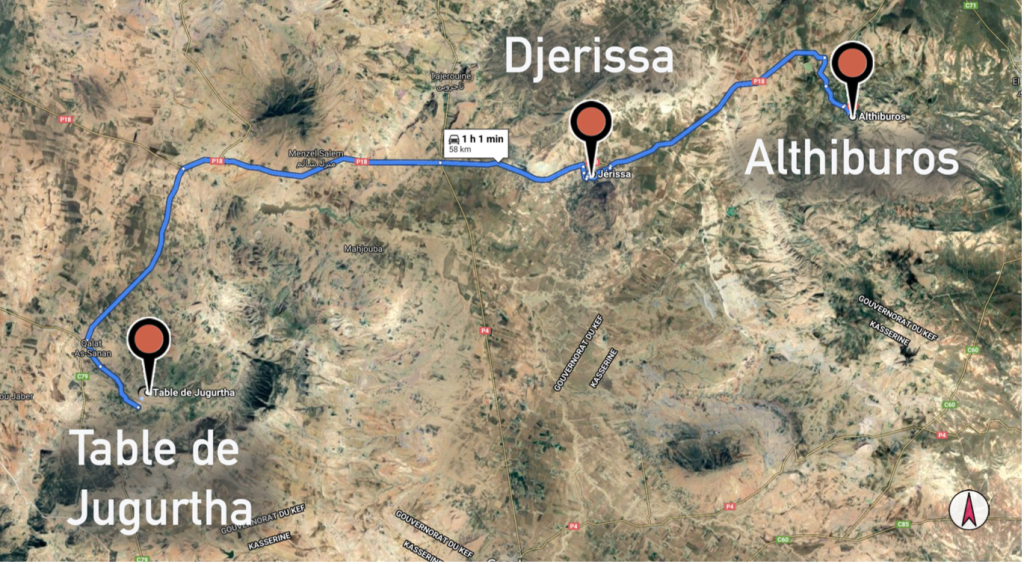
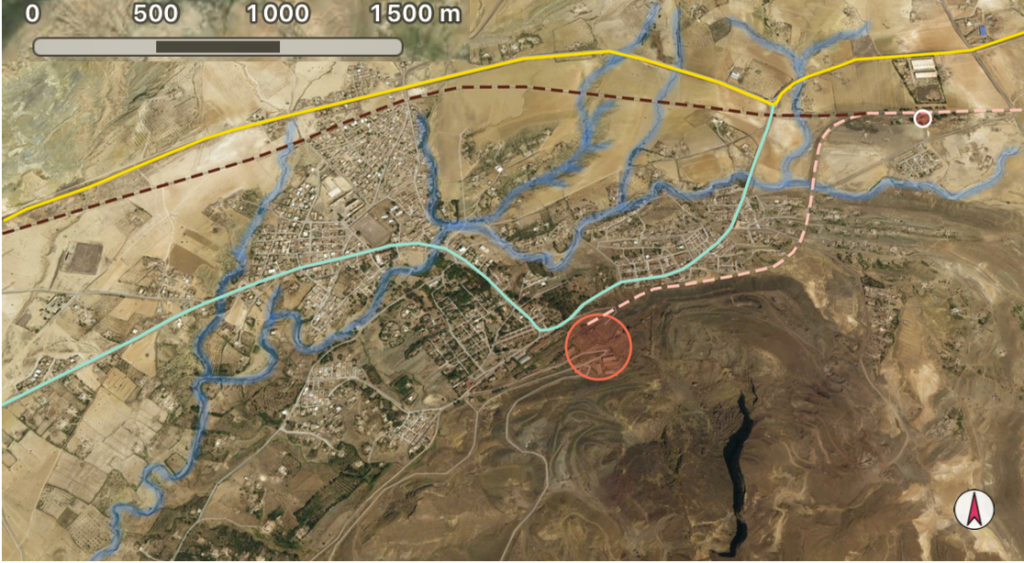

Source : A. Berrajah, 2020, p. 58.
Lors de la découverte du gisement de fer de Djerissa à la fin du XIXe siècle, un réseau de chemins de fer est établi, reliant les points stratégiques des trois colonies du Maghreb. Depuis sa création et la mise en place des installations minières, la cité prévoyait des constructions « nécessaires aux services généraux de la mine, tels que bureaux, directions, magasins, ateliers, infirmerie ; au logement et à la vie du personnel, tels que maisons d'employés, maisons ouvrières, adduction d'eaux, bassins, réservoirs, et aux services d'intérêt général tels que lavoirs, abattoirs, maison d'école, poste de police, etc.»3.
Durant plus d’un siècle, la mine a été le moteur économique du village assurant de l’emploi pour la majorité des habitants de Djerissa, un nombre qui atteint « les 1217 ouvriers et employés de plusieurs nationalités »4. Employant moins d’une centaine d’ouvriers. De nos jours, la cité semble faire face à un déclin causé autant par la crise économique que par l’épuisement des ressources minières.
Les traces d’histoire et de l’identité de la cité minière de Djerissa nécessitent donc l’adaptation aux besoins du XXIe siècle. La mémoire du lieu, du vécu des ouvriers et de ses habitants mérite d’être valorisée et sauvegardée.
Avant d’entamer notre lecture de caractérisation des atmosphères de la cité de Djerissa, nous allons développer notre approche, fondée sur celle phénoménologique de l’architecte Peter Zumthor dans la saisie et la conception des atmosphères architecturales.
2. Approche phénoménologique de caractérisation des atmosphères d’un lieu
2.1. Caractérisation des atmosphères d’un lieu selon Peter Zumthor
Lorsque le concepteur parle d’atmosphère, de sa création, de son langage, de son écriture spatiale, l’ensemble se présente comme une poésie de l’architecture.
Son processus de création semble inédit : Dans un premier temps, il interroge des atmosphères vécues lors de ses expériences passées, décomposant les images qui s’offrent à lui pour comprendre leur sens et ce qu’elles procurent chez lui distinctement comme émotion. C’est alors qu’il les classe et les fait connaître dans leur réalité physique à travers l’identification du corps de l’architecture, l’harmonie des matériaux, le son de l’espace, la température de l’espace et pour finir, la lumière sur les choses. Aussitôt, cette réalité se révèle à lui comme physico-sensible, dans la mesure où les images traduisant une atmosphère spatiale ne peuvent se révéler sans la participation active du sujet, sans son expérience sensible des lieux à travers son corps et ses autres sens.
Ensuite, du moment où il a englobé les composantes physico-sensibles d’une atmosphère, il opère un travail de croisement entre les anciennes images et les nouvelles, plus précisément, ayant en tête les typologies de chaque élément, par un travail de croisement, il cherche à révéler l’effet ambiantal qu’il souhaite atteindre. Ce procédé est très lisible dans ses représentations langagières, car il n’hésite pas à chaque fois à prendre appui sur des exemples pour illustrer ceci, principalement nous l’entrevoyons avec la variation des typologies des matériaux, suivant l’élément qu’il croise et selon l’effet qu’il cherche à créer, à faire chanter, à faire sentir et percevoir.
« Les matériaux s’accordent entre eux et se mettent à chanter, et cette composition matérielle donne naissance à quelque chose d’unique. Les matériaux sont infinis. Prenez une pierre, vous pouvez la scier, la poncer, la percer, la fendre et la polir, elle aura toujours un aspect différent. Considérez ensuite la quantité, petite ou grande, et elle changera de nouveau. Et quand vous la placez dans la lumière, elle change encore. Un seul matériau offre déjà des milliers de possibilités. J’aime ce travail, et plus je le fais, plus il gagne en mystère»5.
Créer une atmosphère, pour lui, c’est inviter au voyage, nous faire vivre des émotions, sensibles d’abord et saisissables dans le monde réel, puis sa charge poétique, nous transporte vers un autre espace-temps, où la sérénité et la magie du réel opèrent. Par ce voyage, par la sublimation de ces atmosphères, l’accès à l’émotion poétique par notre âme devient alors possible. La flânerie qu’il offre dans ses projets se propose comme une invitation à la rêverie, un retour aux souvenirs heureux, un retour aux premières expériences de notre enfance. Ses projets muséaux sont une invitation à l’imagination d’un vécu passé, à un enracinement dans la mémoire du lieu.
L’atmosphère conçue par Zumthor, s’adresse à nous, à notre sensibilité intime, à nos profondes émotions, elle n’est ni une simple sensation, ni une simple perception, elle est un Tout. Ce tout que ce concepteur ne cesse de répéter dans ses textes, un Tout réfléchi à partir des éléments qui le composent, comprenant à la fois les corps matériels et immatériels. Sans ce Tout, l’espace architectural n’a pas d’âme. Cette âme spatiale, cette alchimie, transforme les choses matérielles en sensation humaine et psychique ayant une portée poétique où le corps devient un refuge des émotions du monde. De l’atmosphère comme expérience émotionnelle, le concepteur-rêveur se retrouve alors à former une atmosphère comme expérience du monde.
2.2. Caractérisation des atmosphères de lieu de mémoire selon Peter Zumthor
Peter Zumthor, dans son approche conceptuelle des atmosphères ; accorde beaucoup d’importance à sa mémoire personnelle, aux images de souvenirs et d’expériences passées. Mais face à des lieux chargés d’histoire, il fait appel aux images des mémoires collectives.
« Si l’histoire n’a jamais été absente des préoccupations de l’architecte, les écrits et les propos les plus récents indiquent cependant la place toujours plus grande que prend cette notion au sein de sa pensée et de son œuvre. « Quand vous me demandez ce qui me vient à l’esprit quand je pense au thème de l’atmosphère, c’est la présence de l’histoire : de vieilles usines, des bâtiments industriels – en fait, surtout de vieilles usines en briques : de pures constructions, gorgées d’atmosphère » »6.
Plusieurs de ses projets témoignent de sa réflexion sur l’importance de l’histoire et la mémoire d’un lieu dans la caractérisation de ses atmosphères. On retiendra son intervention architecturale sur le site des mines de zinc abandonnées d’Allmannajuvet sur la côte occidentale de la Norvège, près de la ville de Sauda. Son approche de réflexion sur les quatre structures du musée placées le long de l’ancien chemin de la mine dans la considérable topographie de la gorge évoquent « de différentes façons le temps de la métamorphose de la nature en culture et l’importance accordée à l’expérience subjective des phénomènes esthétiques perçus par les sens »7.
Les composantes physiques du projet rappellent le passé industriel du site, autant par le corps de l’architecture que par les matières mises à contribution, mettant à l’œuvre des pilotis de bois sombres, des toitures de zinc, des murs enduits noirs et des planchers de ciment, de couleur obscure, le tout au contact d’une ambiance lumineuse intérieure sombre. En s’imprégnant de l’identité im/matérielle du lieu, Zumthor a réfléchi l’identité de son musée en harmonie avec l’identité de sa mémoire et de son histoire. Les composantes du paysage norvégien auquel s’intègre le projet, participent dans l’expérience du visiteur, offrant différents points de vue qui guident le corps à travers des séquences ambiantales vers l’entrée de la mine et changeantes selon les saisons.
« À Allmannajuvet, le corps se sent oppressé par les espaces confinés, la lourdeur est perçue physiquement. Le visiteur traverse le site afin d’atteindre les pavillons. Plutôt qu’un déambulatoire contemplatif, le parcours extérieur consiste plutôt en une courte pérégrination durant laquelle le corps confronte le caractère abrupt et historiquement chargé du paysage »8.
«L’expérience auditive est complètement absente des récits bien qu’on puisse imaginer la présence du vent, les chants d’oiseaux, l’écho (…) En ce qui concerne les expériences tactiles au ALL9, le visiteur est en relation de proximité avec les textures du zinc et de la Jute enduite 10 ».
« Le contenu émotionnel de l’expérience du ALL s’établit dès la découverte de l’environnement naturel du musée. Il s’étoffe au contact des vestiges de la mine de zinc »11. Les atmosphères des espaces du Musée Allmannajuvet sont indissociables de leur histoire. L’archéologie industrielle de l’ancienne mine et son passé trouble sont palpables dans l’expérience des visiteurs :
« Le site et le contexte sont les fondements de l’expérience du Allmannajuvet et les espaces construits alimentent le potentiel interprétatif du visiteur. La modestie de l’intervention et des indices offerts au visiteur (une couleur, quatre volumes orthogonaux, trois matériaux) encourage à la présomption et à l’imagination du passé pénible du site. L’histoire du lieu s’adjoint au contexte d’implantation et devient le deuxième axe conceptuel sur lequel s’appuie la fonction commémorative du musée. Les affects et les émotions se manifestent à travers un sentiment d’empathie qui germe chez le visiteur au contact des vestiges industriels et des espaces introvertis, sombres et modestes proposés par Zumthor »12.
Réfléchir à un lieu porteur d’une identité, d’une histoire et d’une mémoire tel que ce musée pour Zumthor, c’est l’envisager dans sa réalité totale et globale. D’abord à travers sa réalité physique, où l’espace en tant qu’objet de réflexion s’exprime pour lui-même par un langage qui lui est propre et qui dévoile sa réelle présence. Pour lui, à travers une flânerie du corps dans le lieu, le paysage, les traces bâties, se révèle une réalité sensible. Zumthor prend en compte les émotions éprouvées par l’usager grâce à ses différents sens au contact des composantes im/matérielles du lieu qui stimule son imaginaire et sa mémoire.
« Lorsqu’on rencontre un lieu, son unité a pour premier visage une atmosphère. Chacun sait qu’un lieu exceptionnel se caractérise par une atmosphère ineffable qui émane de chacun de ces éléments et lui confère une personnalité propre, une âme »13. Cette atmosphère est donc ressentie presque d’une manière intuitive. Elle prend naissance de la somme de tous les éléments, matériels et immatériels, qui composent le lieu. Cette atmosphère fait naître l’esprit du lieu désigné par Schulz comme génie du lieu.
Dans son approche phénoménologique, pour saisir l’atmosphère d’un lieu de mémoire, Peter Zumthor cherche dans son langage à rendre compte à travers cette réalité physico-sensible de l’empreinte des lieux, de la trace du temps et des éléments naturels qui la composent. Plus précisément, il tente de déceler la réalité poétique du lieu à travers la réalité physico-sensible du monde qui l’entoure, l’histoire et la mémoire du lieu. « D’une certaine façon, on peut dire que ma méthode est phénoménologique – avant la compréhension, il y a le regard et l’émerveillement – mais ce qui m’intéresse le plus est de ressentir la temporalité de mes lieux au travers du regard »14.
Cette approche implique que les projets soient reliés à l’histoire du lieu. « C’est important pour moi. Ce qui est resté longtemps muet se met à parler, des lueurs apparaissent, des émotions remontent à la surface et on commence à comprendre »15. D’après lui, l’histoire d’un lieu est conservée physiquement, dans les traces, dans les vestiges, et même les décombres. La compréhension de son histoire et la saisie de sa valeur patrimoniale va au-delà des textes scientifiques et explications didactiques, elle impose l’expérience émotionnelle : « Peut-être pas au-delà, mais différemment ; c’est une compréhension plus émotionnelle qu’intellectuelle »16.
« Les bâtiments peuvent exprimer les sentiments et l’histoire et, surtout, que l’architecture peut donner l’apparence du vivant à une matière morte, éveiller des émotions, des souvenirs et des associations chez l’observateur, et même rendre l’absent présent ou l’invisible visible- tous ces aspects semblent jouer un rôle fondamental dans la façon de voir et de pratiquer l’architecture »17. C’est ce que nous tenterons de valoriser dans notre lecture analytique de la cité minière de Djerissa. Au-delà de son histoire écrite et retranscrite, nous voulons donner parole à ses vestiges, son architecture et son paysage, témoins de son histoire et de la trace du temps passé, dans la finalité d’appréhender toute la complexité de ses atmosphères.
3. Caractérisation des atmosphères de la cité minière de Djerissa
Nous allons procéder dans cette partie à une lecture physico-sensible des composantes de la cité, de la mine et du paysage à trois temps. Dans un premier temps à travers son empreinte im/matérielle marquée par trois moments de rencontre avec la cité Minière. Dans un deuxième temps, à travers la trace du temps. Le troisième temps sera consacré à une lecture introduisant la matérialité physico-sensible et la matérialité poétique à travers les éléments naturels.
3.1. Lecture physico-sensible à travers l’empreinte im/matérielle du lieu
3.1.1. Moment de découverte de la cité minière
Au premier contact avec la cité minière de Djerissa, nous observons cet aspect mystérieux et caché. Pour celui qui n’est pas averti de l’existence d’un carreau minier ancré au creux de la montagne, il est difficile de constater la présence d’interventions humaines d’une telle ampleur. La découverte se fait d’une manière progressive avec un effet de surprise. Des traces des gradins sculptés dans la montagne se dessinent devant nous et on peut distinguer les strates et le relief accidenté du Djebel, une nature dominante, où la structure en métal jaillit petit à petit de la roche, et commence à prendre forme sous nos yeux. Ici, le corps du paysage et le corps de la mine s’entrecroisent au regard sensible du visiteur.
Par ce premier contact, nous commençons à nous interroger sur l’histoire de ce lieu, de l’instant de sa création, les personnes qui l’ont habité et les ouvriers qui ont exploité cette nature à sa surface et dans sa profondeur. Même dans son silence, le lieu commence à stimuler nos sens, à donner une présence à une temporalité décalée, à guider notre perception pour aller à la rencontre des différentes traces matérielles du lieu et de ses composantes physiques.
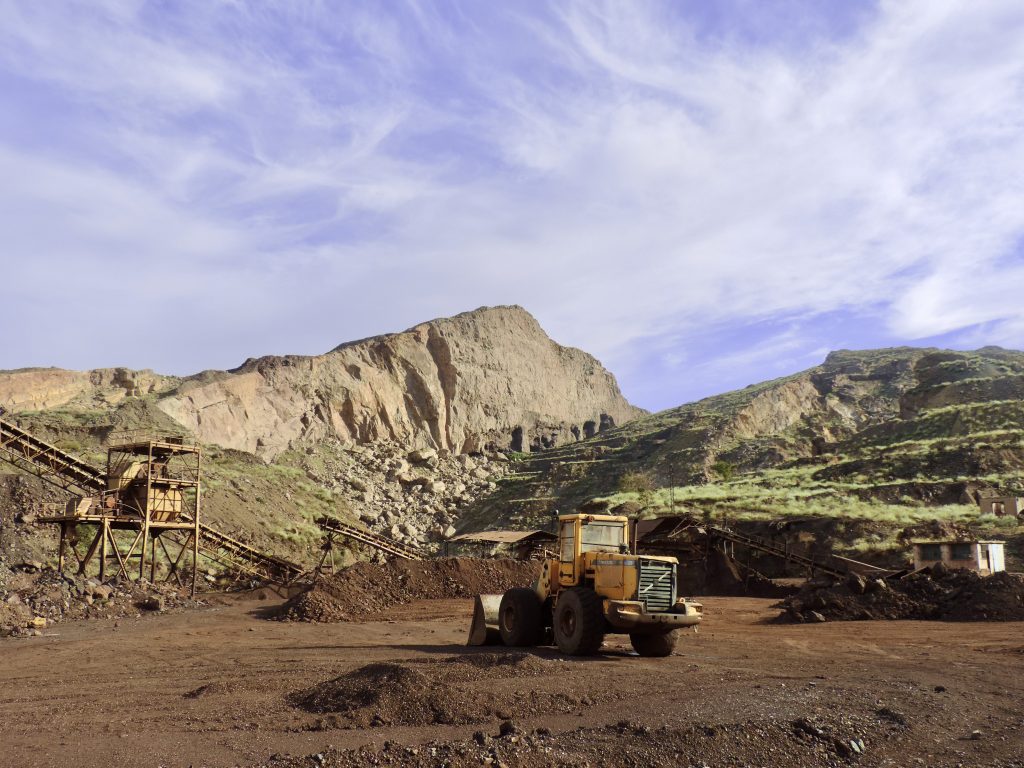
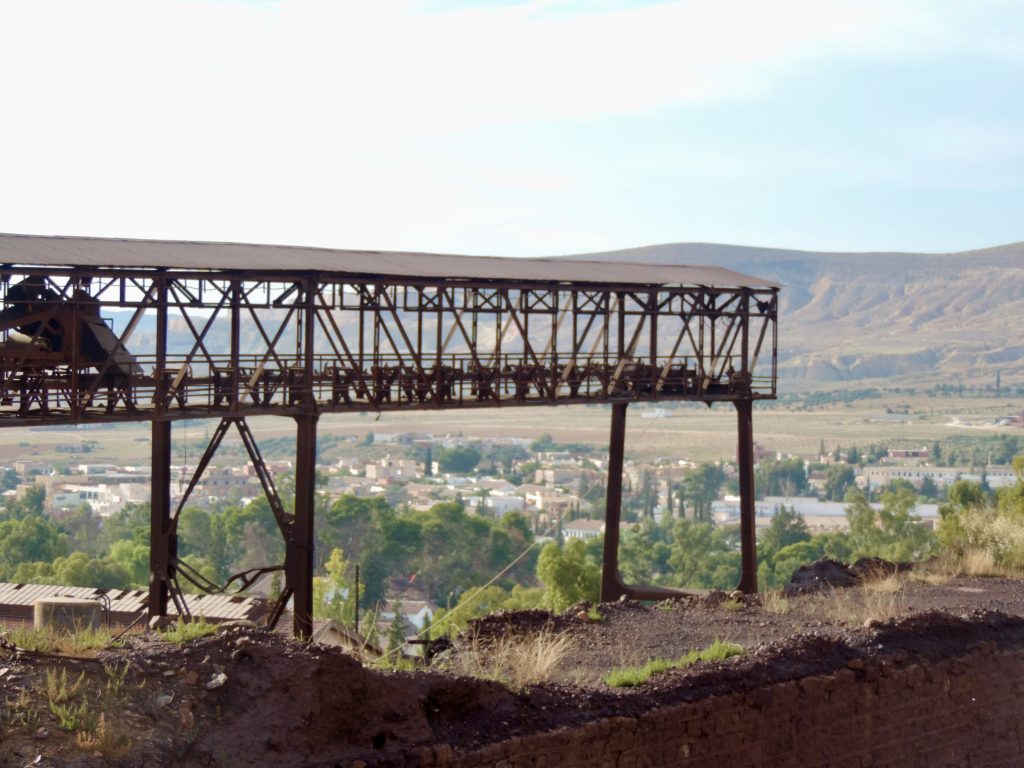
Source : Photos d’A. Berrajah
3.1.2. Une flânerie guidée entre ses bâtiments
« En tant qu’architecte, je m’intéresse à l’histoire qui est conservée et accumulée dans les paysages, les lieux et les objets. Les choses que je peux voir et sentir dans le paysage sont physiques et réelles, peu importe si elles semblent d’abord muettes, cachées et mystérieuses 18».
Arrivés dans le village, nous observons les quartiers résidentiels. Nous constatons la régularité des bâtiments qui présentent pratiquement tous, les mêmes éléments architectoniques caractérisant l’habitation minière en Europe vers la fin du XIXe siècle et le début du XXe siècle : « Le village minier Djerissa présente, comme tous les tissus coloniaux, une trame urbaine relativement régulière avec une hiérarchie des voies de circulation et une voie principale autour de laquelle sont structurés les bâtiments publics et les voies secondaires qui mènent vers les quartiers résidentiels. On y distingue aussi la présence des voies d’accès vers le Djebel pour les engins et un chemin de fer pour le transport public et industriel »19 .
À travers une flânerie guidée entre les rues et ruelles, nous avons distingué les différentes typologies des logements localisés du village de Djerissa. Ces logements se conforment aux différents modèles d’habitat minier.
L’organisation de ces habitations suit des trames orthogonales et des délimitations précises, chose peu commune dans les petits villages ruraux en Tunisie. Les toitures sont marquées par la tuile rouge devenue rouille et fade avec le temps, la brique rouge qui surplombe les ouvertures sous forme d’arche bombée en saillie et marque l’encadrement des ouvertures. Les proportions classiques des fenêtres donnent aux habitations un aspect rustique. Par ce contact avec les composantes physiques des habitations de la cité, par une perception sensible des objets et des traces matérielles qui composent l’identité du lieu, commence à se révéler à nous au travers d’une « synchronisation d’une expérience personnelle, subjective et asynchrone avec un cadre factuel et chronologique »20, une empreinte immatérielle, celle « du tissage d’une histoire locale dans la texture d’une histoire universelle » .
Nous identifions plusieurs édifices, localisés sur l’axe principal de la ville, témoins de l’identité historique du lieu. Cette lecture physico-sensible de ces empreintes matérielles du lieu nous invite à l’imagination ; comment se déroulait le quotidien des anciens habitants de Djerissa à travers ces points de repères marquants dans le village, comme l’hôtel de ville devenu la municipalité ou l’église qui abrite actuellement un musée minier. Nous imaginons une certaine dynamique sur cette avenue principale du village, mais un vécu passé soumis à un contrôle permanant21.
Nous identifions plusieurs édifices, localisés sur l’axe principal de la ville, témoins de l’identité historique du lieu. Cette lecture physico-sensible de ces empreintes matérielles du lieu nous invite à l’imagination ; comment se déroulait le quotidien des anciens habitants de Djerissa à travers ces points de repères marquants dans le village, comme l’hôtel de ville devenu la municipalité ou l’église qui abrite actuellement un musée minier. Nous imaginons une certaine dynamique sur cette avenue principale du village, mais un vécu passé soumis à un contrôle permanant.
Ces édifices, bien que moins imposants que les quartiers d’habitations, sont tous aussi iconiques du carreau minier. La manière dont est théâtralisé l’espace par l’assemblage de géométries simples, la variation des hauteurs, des ouvertures, des cadrages, mais aussi par l’ombre et la lumière, permettent à l’individu de s’identifier à des lieux passés et de les éprouver réellement, sans vraiment les percevoir. Cette flânerie nous a permis d’appréhender dans un premier temps l’empreinte im/matérielle de l’histoire de la cité minière de Djerissa, sans être imprégnés par la facette négative des vécus des mineurs d’autrefois.
Mais au-delà de ses traces bâties, l’empreinte de ce lieu ne peut s’offrir à nous dans sa globalité, qu’en la vivant et l’expérimentant dans sa totalité, c’est-à-dire à travers son paysage industriel, son carreau minier, lieu de vie et de travail d’autrefois, et son paysage naturel.

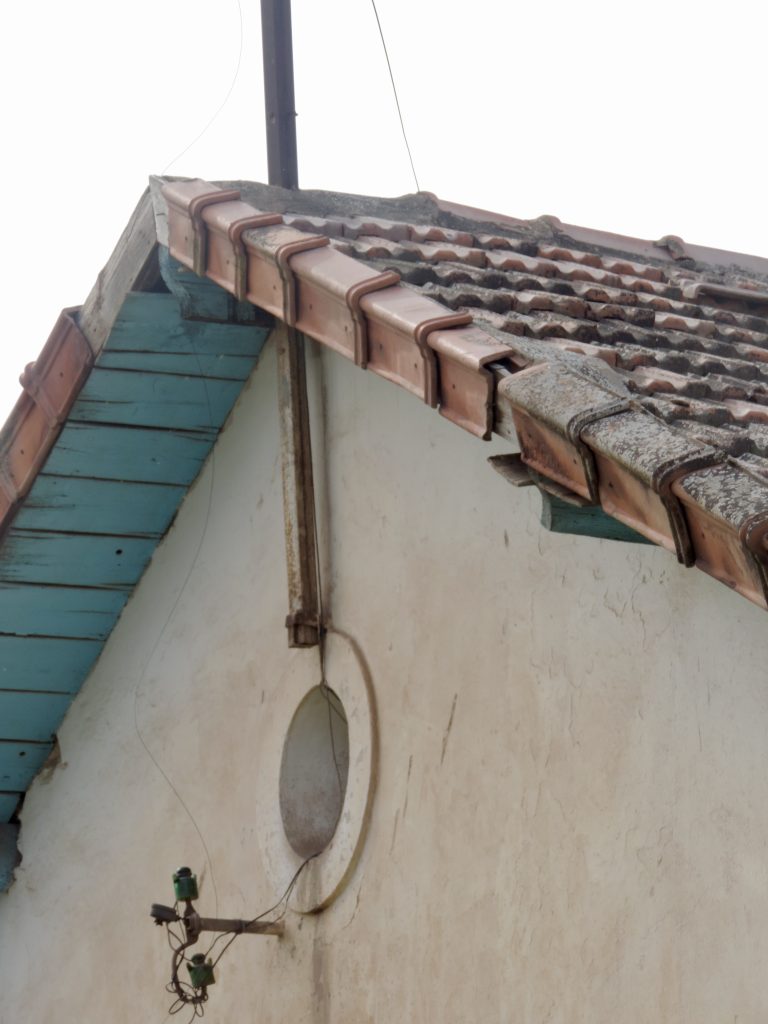

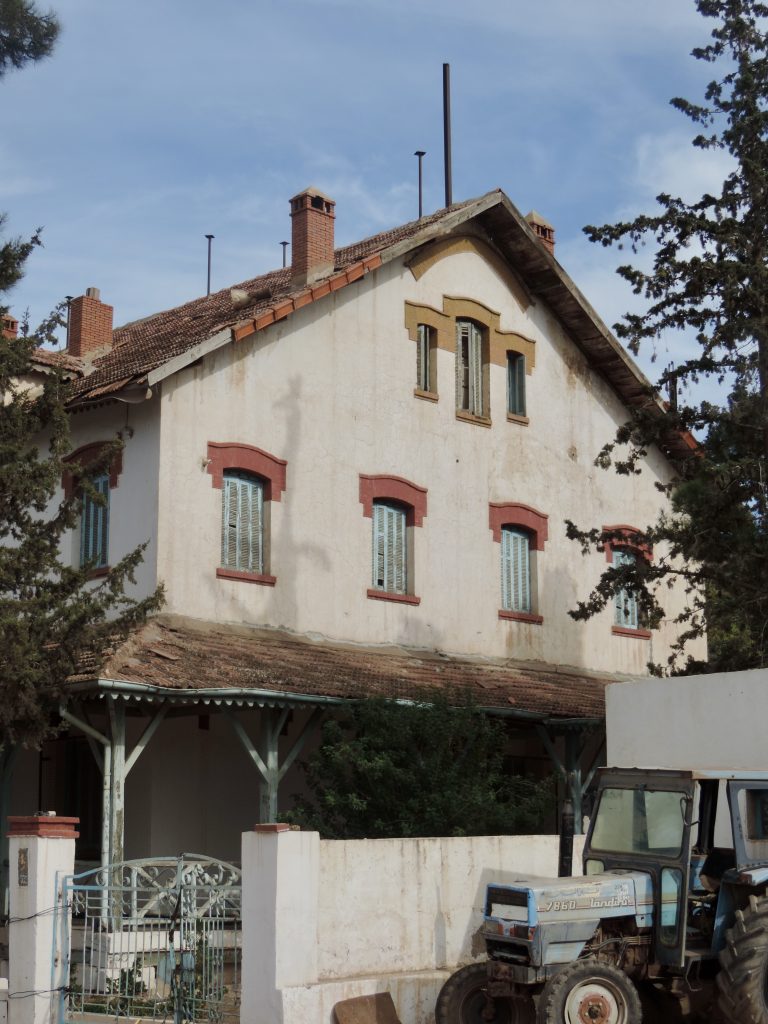

Source : Photos d’A. Berrajah.
3.1.3. Une flânerie entre révélation et séduction dans le carreau minier
Au contact du carreau minier, implanté au pied de la montagne Djebel Djerissa, nous nous laissons guider par une flânerie libre mais révélatrice d’une nouvelle identité du lieu. Les différents engins et structures du carreau minier se présentent comme des composantes physiques complémentaires au cadre bâti, par leur présence et leur ancrage au sol, par leur dominance au cadre bâti et par la variété de leurs matérialités et textures révélées à nous grâce aux jeux d’ombre et de lumière : « La lumière et l’ombre, les transparences et les profondeurs, les phénomènes colorés, le jeu des matières et des textures, celui des dimensions, la présence de volume parfois plein, parfois vide, les relations d’échelle, le dialogue avec la taille de notre corps, les rapports d’ouverture et de fermeture de compression spatiale, la relation entre l’horizon et le proche sont autant d’éléments qui participent de manière simultanée à la découverte et à l’appréhension d’un lieu »22 .
La plupart de ces engins du carreau sont dans un état de détérioration avancée. Ils sont rongés par la corrosion et l’usure du temps. Les structures en béton comme la trémie et le pont d’arcades qui conduit au niveau supérieur du carreau ont pu résister au passage du temps. Ces structures marquées par leur monumentalité, nous procurent un sentiment d’écrasement, mais aussi de séduction face à cet entrelacement entre nature et artifice, entre montagne et structure, surplombant tout le village.
Cette perception des composantes im/matérielles des vestiges de la mine stimule notre imagination et nous invite à accéder à la réalité poétique du lieu, une réalité qui concentre en elle plusieurs temporalités. Dans l’instant présent à sa contemplation, nous sommes face à une temporalité figée. Mais au-delà de cette contemplation, dans la racine de ses empreintes im/matérielles, l’histoire du lieu et du vécu passé s’offre à nous, latente et manifeste.


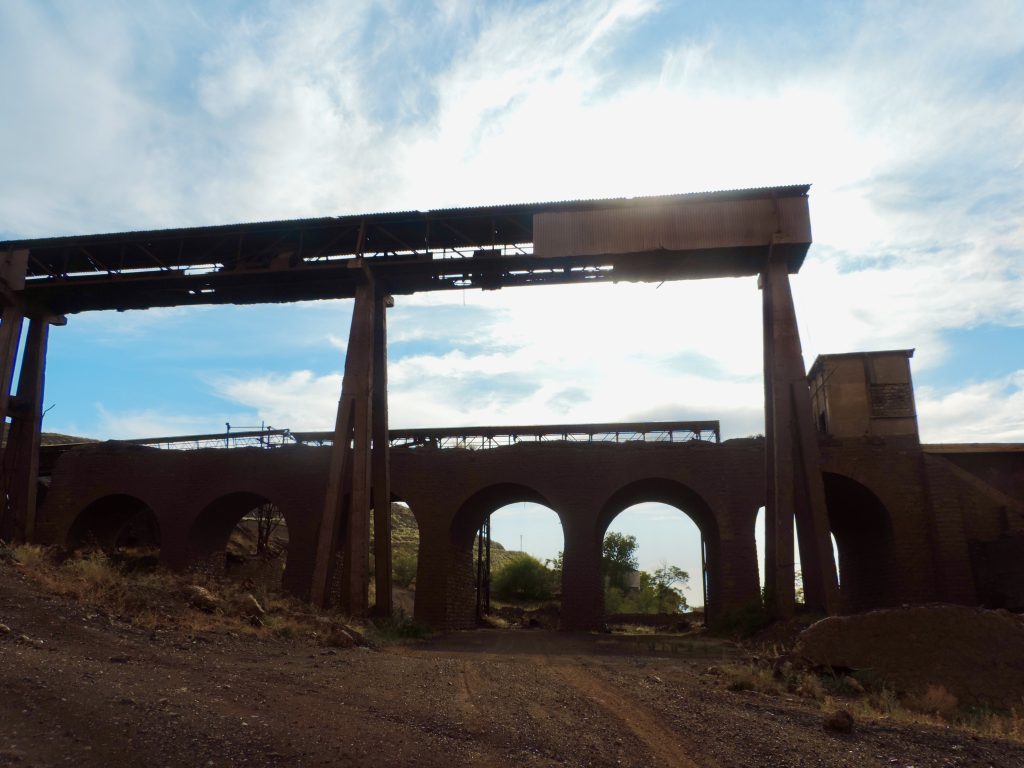
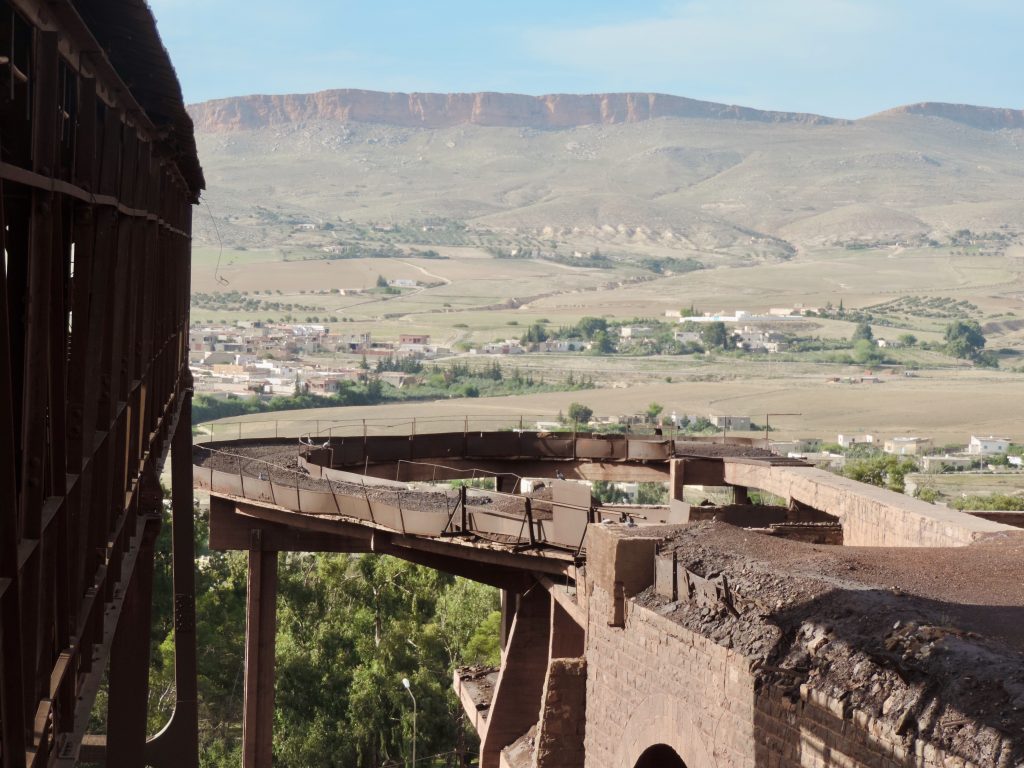
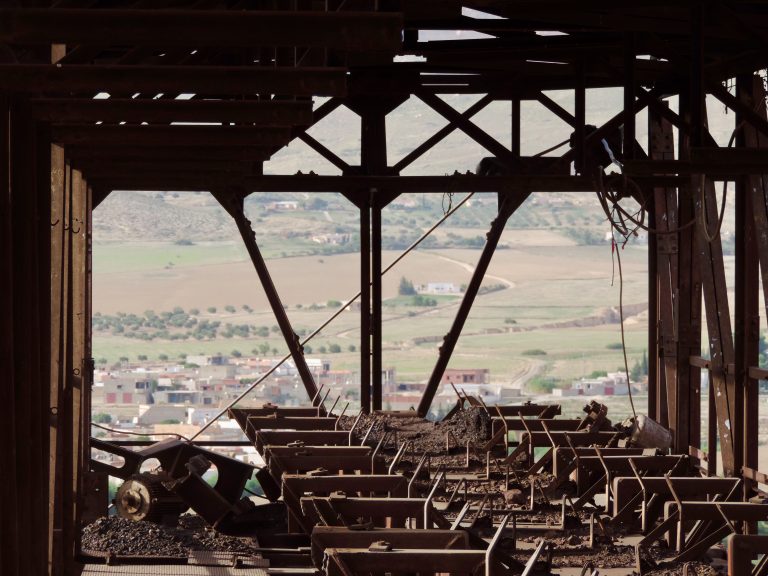

3.2. Lecture physico-sensible à travers la trace du temps
Lors de notre rencontre avec la cité minière de Djerissa, entre ses bâtiments coloniaux, son paysage naturel et son paysage industriel du carreau de mine, entre ses empreintes matérielles et immatérielles, s’est révélée à nous son histoire. Cette expérience a provoqué en nous un sentiment de voyage dans le temps, car selon Zumthor, c’est « le lieu qui transmet une autre manière de sentir l’histoire, bien plus profonde que l’histoire académique. On pourrait dire que l’histoire du lieu devient vivante par l’expérience qu’on en fait »23. « Les paysages et les lieux conservent des souvenirs, ils gardent les traces d’une vie qui a disparu depuis longtemps. Ces traces me fascinent parce qu’elles sont réelles, uniques, toujours authentiques. Les paysages sont pour moi des documents historiques. Je peux essayer de lire et d’interpréter le lieu où je dois agir en tant qu’architecte »24.
L’histoire de la ville de Djerissa est rattachée à l’histoire de sa mine et aux lieux que nous avons découverts sont marqués par la trace du temps. Ils sont porteurs du passé, tout en gardant une marque et une empreinte authentique dans le paysage qui l’englobe.
En percevant toutes ces traces, ces différentes structures surplombant la ville, figées dans l’espace et dans le temps sans aucune âme pour certains, mais présente et pérenne pour d’autres par leur force à résister à l’usure du temps, le visiteur est envahi par un sentiment ambigu, celui d’être témoin de la présence d’une absence. Il est certain que ce paysage industriel à l’instant présent règne un silence dominant, autrefois était envahi par le mouvement et le flux des travailleurs qui se précipitaient tous les matins en direction de la mine. De mouvements et de bruits, le dynamisme et la frénésie qui régnait dans le carreau avec tous les engins en marche...Un sentiment de souffrance nous envahit, celui du vécu des mineurs sous ces machines et dans l’obscurité de la mine, affaiblie jour après jour. Hommes en souffrance en silence …
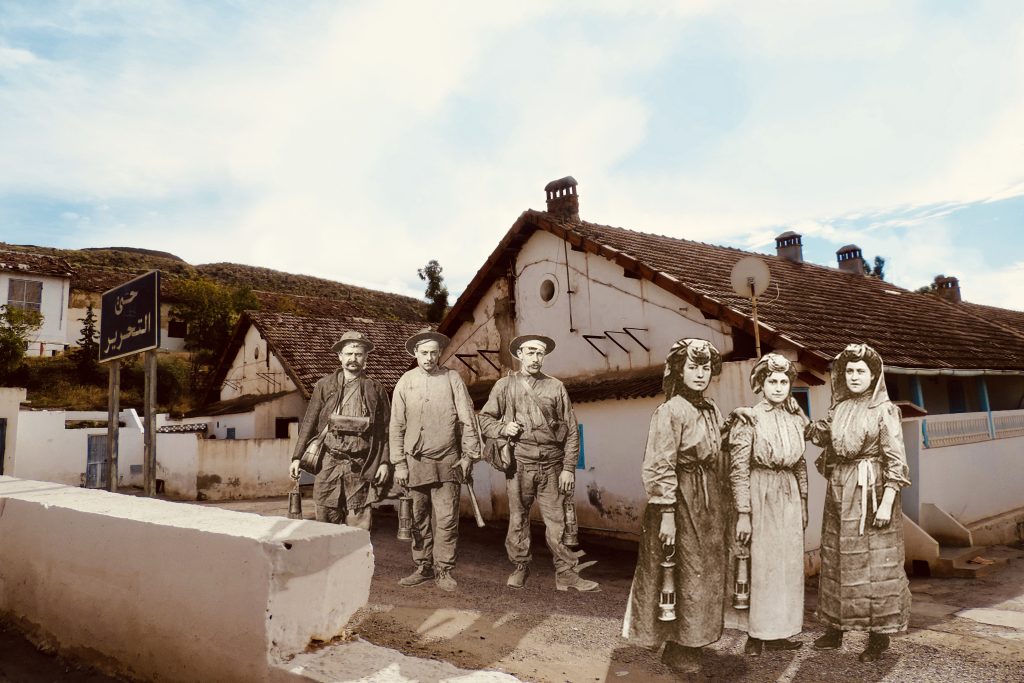
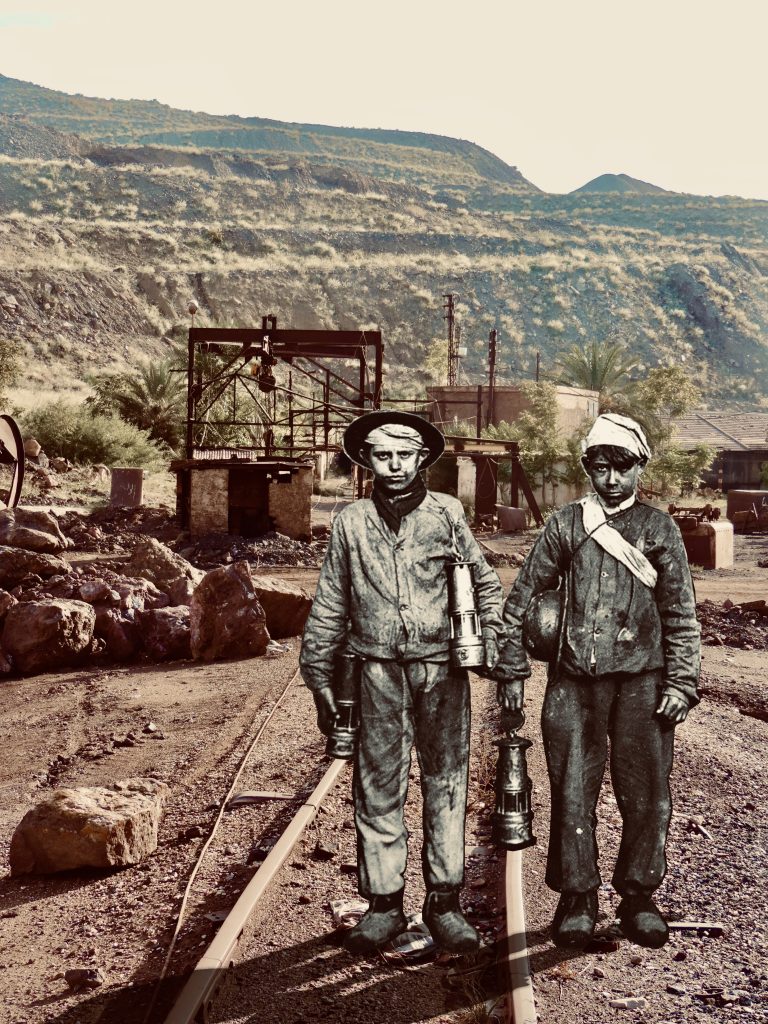
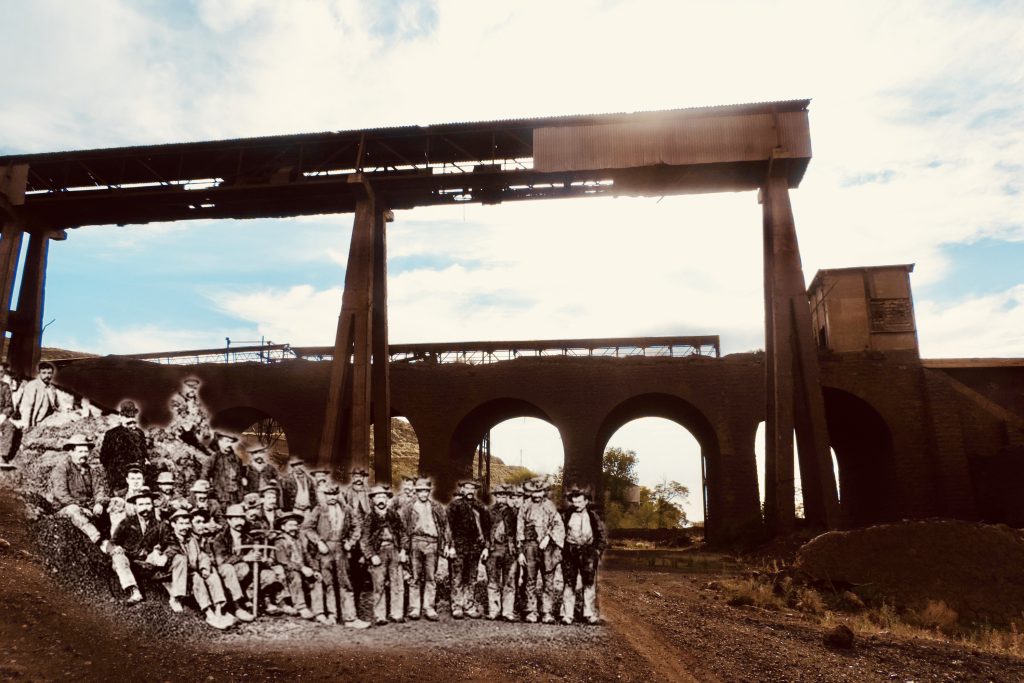
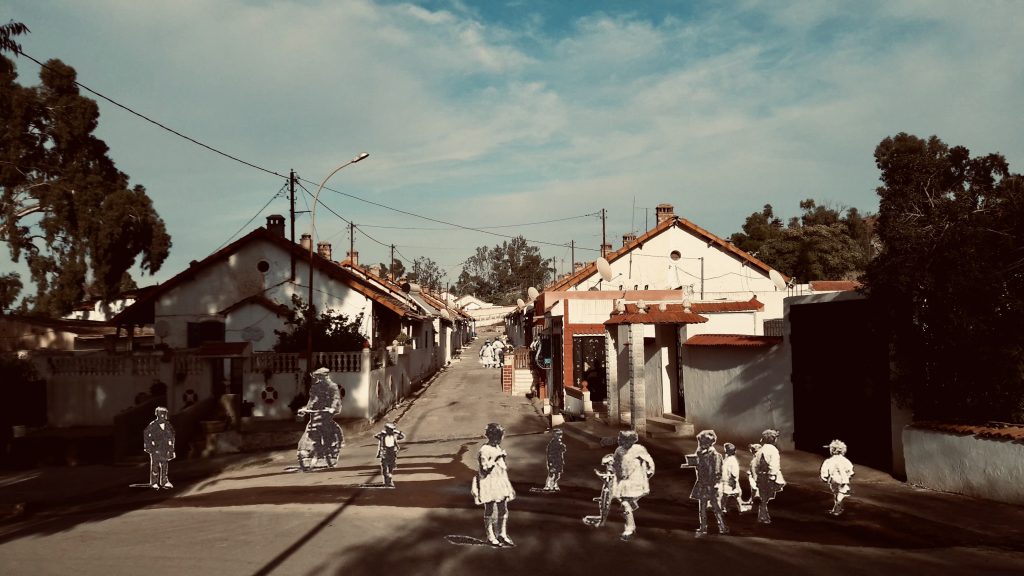
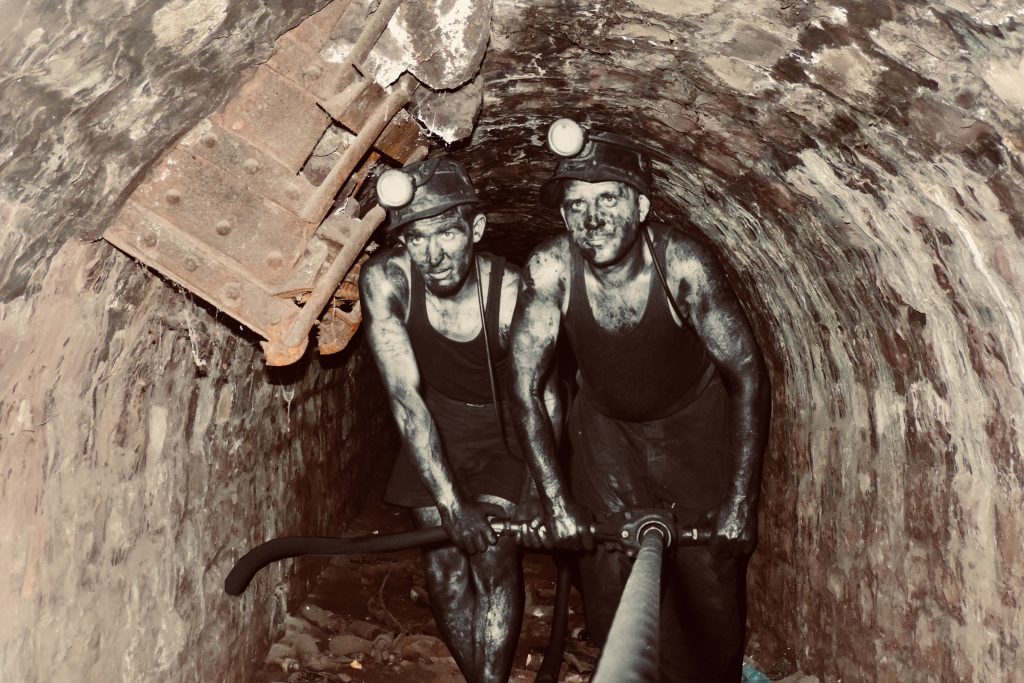
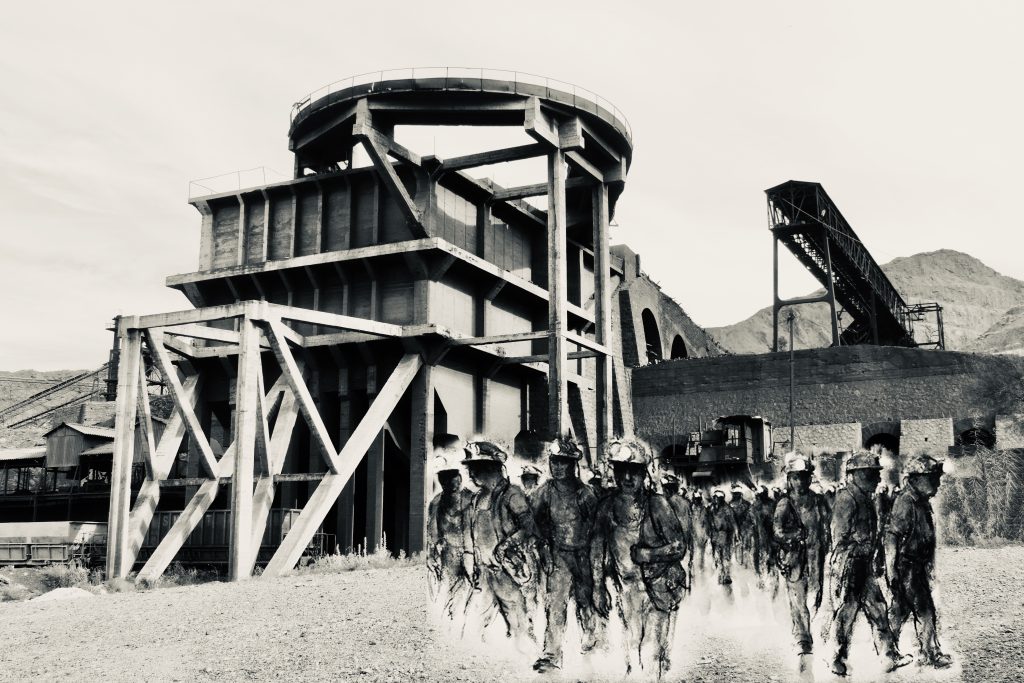
Source : Photos-montage d’A. Berrajah
La contemplation de cette ville en suspens, éveille notre imagination, ou notre mémoire collective, attachées aux histoires racontées sur ces lieux débordant de mouvement à une époque passée.
« Les gestes physiques d’un bâtiment sont plus primaires, plus directement reliés aux capacités sensorielles de notre corps que les pensées ou les mots (...) l’art et l’architecture gardent la mémoire de l’humanité vivante25 » .
3.3. De la matérialité physico-sensible à la matérialité poétique à travers les éléments naturels
La lecture physique et sensible d’un lieu trouve aussi son essence dans les éléments naturels. L’élément auquel le concepteur Peter Zumthor accorde beaucoup d’importance lors de l’appréhension d’un lieu est la matière, associée à l’élément terre. Djerissa est bâtie entre deux montagnes, ce qui affirme son ancrage matériel à la terre.
Ces montagnes dépourvues de végétation dense, possèdent des tons variés de couleur terre, très proche des valeurs trouvées dans le noyau urbain et dans le carreau de mine. Cela crée une harmonie entre le paysage naturel et le paysage urbain artificiel, accentuée par les variations de textures entre les différents matériaux (acier, tôle, béton, pierre et brique), et par la trace de l’usure du temps : « Je crois que, dans le contexte de l’objet architectural, les matériaux peuvent revêtir des qualités poétiques. Mais il faut pour cela créer, au sein de l’objet lui-même, un certain rapport de forme et de signification, parce que les matériaux ne sont intrinsèquement pas poétiques
26».
Pour parvenir à donner du sens au matériau et à révéler ses qualités poétiques, Zumthor ne l’aborde pas d’une manière séparée, bien au contraire, c’est par sa confrontation avec les autres éléments que sa réalité devient englobante. Par la lumière, il cherche à l’aborder suivant ses différentes formes et reflets, il étudie son acoustique ainsi que l’odeur qu’elle exprime dans l’air et aussi par la présence de l’eau, il explore ses effets de reflets. La manière avec laquelle nous appréhendons la matière à Djerissa, va au-delà des qualités sensorielles. C’est à travers leur résonance et leur rayonnement, qu’elle permet de nous engager dans une expérience ambiau-poétique du lieu, où nos sensations et nos émotions s’animent. C’est "la magie du réel" comme la définit Zumthor : « pour moi la magie du réel, c’est l’«alchimie» de la transformation des substances matérielles en sensations humaines, ce moment particulier d'appropriation ou d'assimilation de matière, de matériau et de forme dans un espace architectural »27.
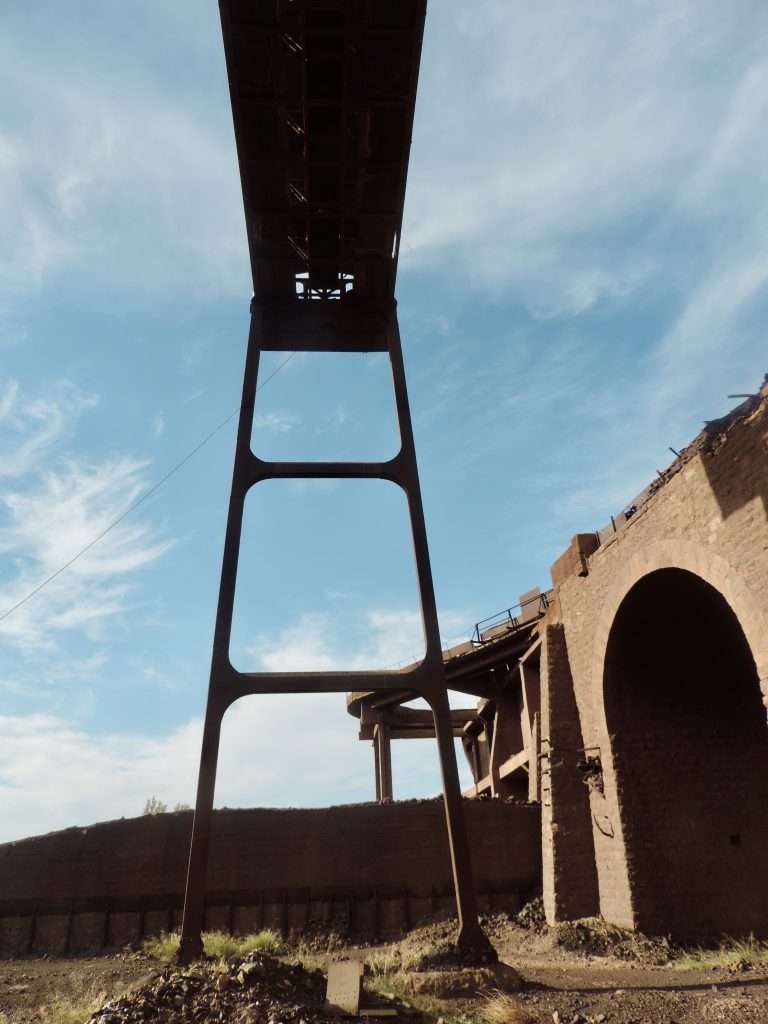
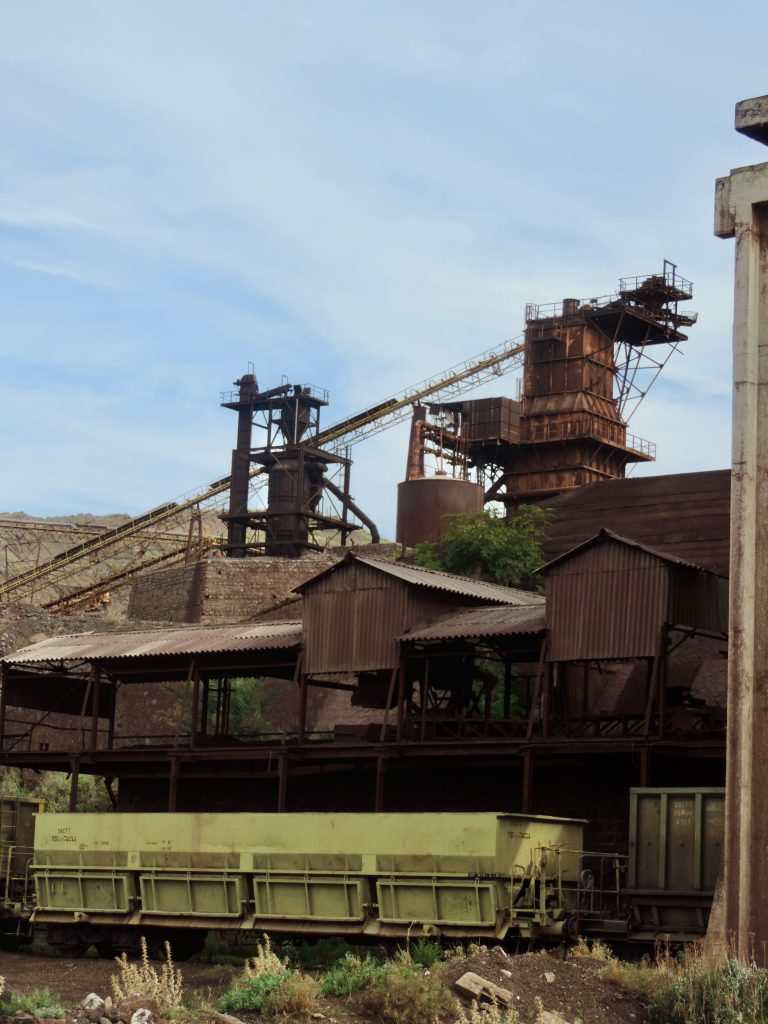


Source : Photos d’A. Berrajah.
Conclusion
Au terme de ce travail d’appréhension de l’esprit de la cité minière de Djerissa, d’autres interrogations se posent. Abordant un patrimoine minier à travers ses atmosphères, de quoi devons-nous parler, de son histoire ? De son passé ? Ou plutôt de ses multiples temporalités ?
Le concepteur Peter Zumthor a été confronté à ces mêmes interrogations dans son processus conceptuel dans le projet du musée Allmannajuvet Zinc Mine. Selon lui : « Ce n’est visiblement pas le passé, mais peut-être un sentiment du passé, un sens du temps. J’essaie d’ouvrir une fenêtre par laquelle nous pouvons voir les choses et des vies qui étaient là avant nous et découvrir des traces du passé. J’offre un nouveau cadre pour une expérience qui éveille une conscience émotionnelle de l’histoire du lieu »28.
On pourrait dire que Djerissa est un musée en plein air, qui travaille avec des vestiges authentiques. Les petites et grandes traces im/matérielles, les bâtiments coloniaux, les sentiers de la mine ainsi que les objets qui la composent sont des traces concrètes dans le paysage. Ce sont des lignes réelles, actuelles. Notre approche en tant qu’architecte cherchant à révéler l’âme cachée de ce patrimoine laissé à l’oubli, consiste à sentir l’histoire du lieu et à « essayer de rendre les choses visibles de manière à ce que les gens puissent y apporter une réponse émotionnelle, par leur sensibilité, plutôt que d’apprendre passivement l’histoire du site »29.

Source : Photo-montage par l’auteur d’après photos d’A. Berrajah